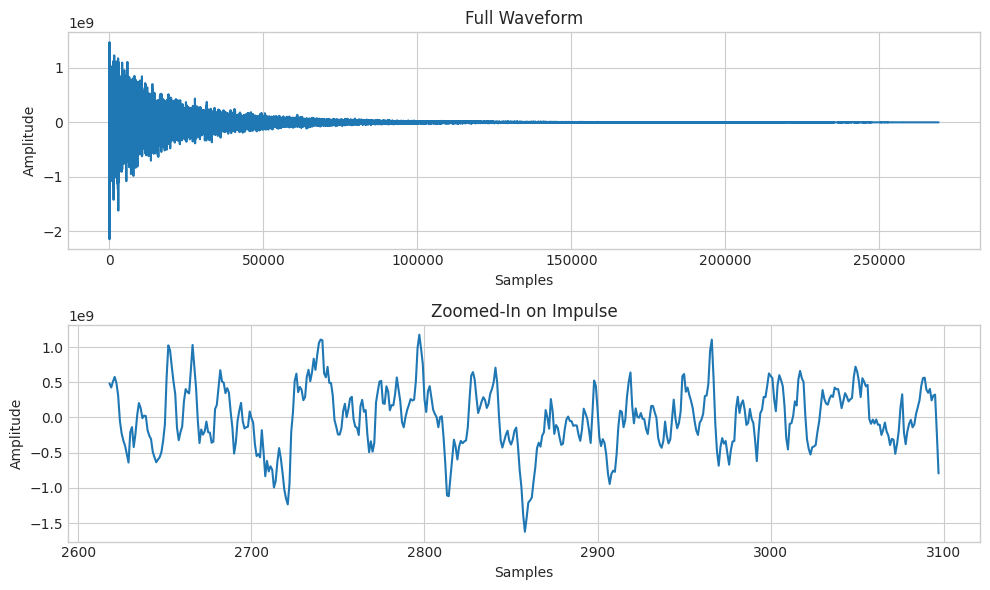Plot Impulse Response (IR) with zoom#
import numpy as np
from scipy.io import wavfile
from scipy import signal
from matplotlib import pyplot as plt
plt.style.use('seaborn-v0_8-whitegrid')
plt.rcParams['axes.grid'] = True
---------------------------------------------------------------------------
ModuleNotFoundError Traceback (most recent call last)
Cell In[1], line 1
----> 1 import numpy as np
2 from scipy.io import wavfile
3 from scipy import signal
ModuleNotFoundError: No module named 'numpy'
sample_rate = 48000
bx20_ir = wavfile.read('./audio/IR_AKG_BX25_3500ms_48kHz24b.wav')[1]
def plot_impulse_with_zoom(data, sample_rate, zoom_factor=0.01):
"""
Plot the waveform and zoom in on the impulse.
Parameters:
- data: The impulse signal data.
- sample_rate: The sample rate of the data.
- zoom_factor: The fraction of the total duration to show around the impulse.
"""
# Identify where the impulse is (find the sample with the highest absolute amplitude)
impulse_index = np.argmax(np.abs(data))
# Compute the number of samples to show around the impulse for zooming
samples_to_show = int(sample_rate * zoom_factor)
# Define start and end indices for the zoomed view
start_index = max(0, impulse_index - samples_to_show // 2)
end_index = min(len(data) - 1, impulse_index + samples_to_show // 2)
# Create plots
fig, axs = plt.subplots(2, 1, figsize=(10, 6))
# Full waveform
axs[0].plot(data)
axs[0].set_title("Full Waveform")
axs[0].set_xlabel("Samples")
axs[0].set_ylabel("Amplitude")
# Zoomed-in waveform
axs[1].plot(range(start_index, end_index), data[start_index:end_index])
axs[1].set_title("Zoomed-In on Impulse")
axs[1].set_xlabel("Samples")
axs[1].set_ylabel("Amplitude")
plt.tight_layout()
plt.show()
# Test with the impulse signal from the previous code snippet
plot_impulse_with_zoom(bx20_ir, sample_rate)

def plot_impulse_and_spectrogram(data, sample_rate, zoom_factor=0.01):
"""
Plot the waveform, zoom in on the impulse, and display its traditional spectrogram.
Parameters:
- data: The impulse signal data.
- sample_rate: The sample rate of the data.
- zoom_factor: The fraction of the total duration to show around the impulse.
"""
# Identify where the impulse is (find the sample with the highest absolute amplitude)
impulse_index = np.argmax(np.abs(data))
# Compute the number of samples to show around the impulse for zooming
samples_to_show = int(sample_rate * zoom_factor)
# Define start and end indices for the zoomed view
start_index = max(0, impulse_index - samples_to_show // 2)
end_index = min(len(data) - 1, impulse_index + samples_to_show // 2)
# Extract zoomed data
zoomed_data = data[start_index:end_index]
# Compute the spectrogram of the zoomed data
f, t, Sxx = signal.spectrogram(zoomed_data, fs=sample_rate)
# Create plots
fig, axs = plt.subplots(3, 1, figsize=(10, 8))
# Full waveform
axs[0].plot(data)
axs[0].set_title("Full Waveform")
axs[0].set_xlabel("Samples")
axs[0].set_ylabel("Amplitude")
# Zoomed-in waveform
axs[1].plot(range(start_index, end_index), zoomed_data)
axs[1].set_title("Zoomed-In on Impulse")
axs[1].set_xlabel("Samples")
axs[1].set_ylabel("Amplitude")
# Traditional spectrogram
cmap = plt.get_cmap('inferno')
min_magnitude = 10 * np.log10(np.min(Sxx))
max_magnitude = 10 * np.log10(np.max(Sxx))
for i in range(len(t)):
magnitudes = 10 * np.log10(Sxx[:, i])
normalized = (magnitudes - min_magnitude) / (max_magnitude - min_magnitude)
colors = cmap(normalized)
axs[2].vlines(t[i], f[0], f[-1], colors=colors, lw=2, linestyles='solid')
axs[2].set_title("Spectrogram")
axs[2].set_ylabel("Frequency [Hz]")
axs[2].set_xlabel("Time [sec]")
plt.tight_layout()
plt.show()
# Replace the following with your actual data and sample rate.
plot_impulse_and_spectrogram(bx20_ir, sample_rate, zoom_factor=0.01)



